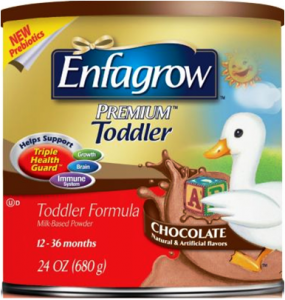Mead-Johnson defends Vanilla Enfagrow
A reporter sent me this message from Christopher Perille, Mead-Johnson’s Vice President – Corporate Communications & Public Affairs, about the company’s Chocolate and Vanilla sweetened Enfagrow toddler formula, advertised with health claims. It seems only fair to present the company’s defense of its products. Here’s what he says:
Enfagrow Premium products contain a balanced blend of protein, fat, carbohydrates and other key nutrients, offered in a form designed to be appealing to even the pickiest eaters. These products were introduced in the U.S. to provide additional nutrition as part of a normal healthy diet for toddlers who have been weaned off breast milk or infant formula. While we recognize that each toddler — and his or her eating habits and nutritional needs — are different, they can often have rather narrow palettes and relatively short lists of acceptable foods. My daughter, for one, had an extended period of time during which hot dogs, chicken fingers and french fries were three of her primary food groups. Happily, her tastes eventually expanded, and she is now a healthy and happy sophomore at Washington University in St. Louis — but there was certainly a time when I was concerned whether or not she was getting all the nutrition she needed.
Enfagrow Premium vanilla has been in the marketplace for nearly a year and has elicited numerous positive comments from grateful parents. They have told us that they consider these products an important option for helping to meet their child’s overall nutritional needs, especially those who are picky or erratic eaters, so as to help provide additional assurance that toddlers achieve their recommended nutrient intake.
As we discussed, you were looking at older packaging. The current labeling for Enfagrow Premium vanilla, indicates 17 grams of total sugar, but even that is overstated due to precautionary rounding — the real figure probably falls closer to 15 (14-16). The majority (approximately three-quarters) of the sugar in our product comes from lactose (that is naturally occurring in milk). So while we do add a small amount of sugar (about 4 grams or 1 teaspoon in a 7 fl. oz. serving) to our Enfamil Premium vanilla product to improve the for finicky eaters, the sugar in our flavoring equates to about 15 calories and is less than 2% of a toddler’s daily allowance of calories.
By comparison, the chocolate-flavored version contained less lactose and required more added sugar to overcome the bitterness of cocoa to make it palatable, so the sugar from lactose accounted for just over half the total sugar.
Even with the added 15 calories of sweetness, Enfagrow Premium vanilla has a superior nutritional profile to many other beverages regularly consumed by toddlers – including apple juice, grape juice and similarly flavored dairy drinks.
Enfagrow products also have beneficial ingredients include iron to help support brain growth and antioxidants and other nutrients to help support the immune system. Additionally these products are also a source of Omega-3 DHA and prebiotics, both of which are lacking in milk. Finally, these products exceed whole milk – serving for serving – for important vitamins such as A, B1, B6, C and E.
Enfagrow Premium products – flavored and unflavored – can be part of a balanced diet, which in combination with routine physical activity and an overall healthy lifestyle, can help avoid obesity. In fact, a peer reviewed article published in April 2008 in the Journal of the American Dietetic Association – based on a study of over 7,500 children and adolescents from ages 2 to 18 – found that consumption of either flavored or plain milk is associated with a positive influence on nutrient intakes by children and adolescents. Additionally, consumption of flavored milk was not associated with adverse effects on Body Mass Index (BMI), a commonly used indicator of obesity.
Convinced? I’ve said all I have to say about these products in previous posts. You decide.



 The company’s philosophy: Your toddler won’t drink milk? Try chocolate milk!
The company’s philosophy: Your toddler won’t drink milk? Try chocolate milk!